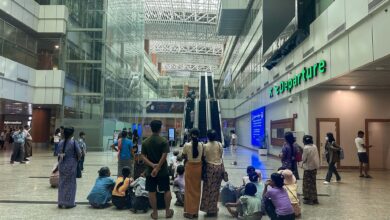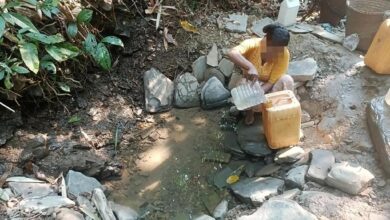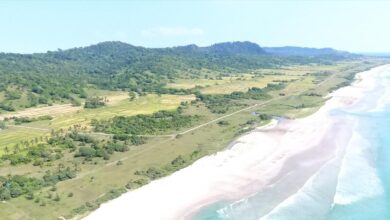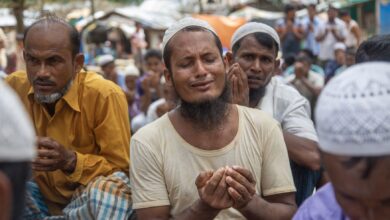
On April 22, the leader of Myanmar’s coup regime appeared on state television to call for peace talks, even as troops under his command were torching villages in Sagaing Region suspected of harbouring resistance forces.
“I invite leaders of ethnic armed groups for dialogue,” said Senior General Min Aung Hlaing, vowing to meet all of the groups in person. He added that those who wished to attend the planned talks should register by May 9.
Just five days earlier, the regime had announced that the leaders of five ethnic armed organisations (EAOs) were to receive honorary awards for their service to the country.
The reason for this awkward charm offensive was obvious to most observers: More than a year after seizing power, Myanmar’s military has been significantly weakened by the armed anti-coup resistance movement. With battles raging in areas that were previously free of conflict, the regime’s forces are overstretched and exhausted.
By winning over at least some of the country’s ethnic armies, the junta may be hoping to avert a further worsening of the situation on the ground, where casualties among junta troops are high and morale is low.
There are signs, however, that its outreach efforts are too little, too late.
At this point, the regime controls barely half of the country, according to Nyi Thuta, an army captain who defected to the Civil Disobedience Movement (CDM) last year. The rest—mainly in rural areas—is now largely in the hands of EAOs and groups formed since last year to fight the newly installed military council.

This reality has only deepened the reluctance of many in the armed forces to continue a fight that the generals seem unable to win, despite their superior firepower and brutal tactics.
“Soldiers who pledged their lives to the armed forces will not keep fighting if it goes on like this. We know there are many who want to quit,” said Nyi Thuta, who founded People’s Goal, an organisation that helps military defectors escape to liberated areas.
“The military is falling apart and will soon collapse,” he predicted.
Losing hearts and minds
According to the shadow National Unity Government (NUG), more than 3,000 soldiers and 7,000 police officers have joined the CDM since last year. It also claims that many more have abandoned their posts without formally crossing to the other side.
Those who do defect to anti-regime forces are well-treated, as are troops who surrender in battle—unlike those captured by the regime, who are routinely tortured and executed. This has also contributed to a growing willingness among junta soldiers to join the resistance. Rumours that defectors might qualify for asylum in Australia have also created an incentive for some.
The Tatmadaw, or Myanmar armed forces, is usually estimated to have around 400,000 troops at its disposal. The current figure, however, could be as low as half that number, according to some observers. At this level, the military may have difficulty maintaining its command structures, they say. How many troops have actually been deployed to combat zones is another question.
While it is impossible to know with any certainty just how many soldiers are still serving in the military, it is clear that its ranks have been depleted by the ongoing conflict.
Kyaw Zeya, a former lieutenant colonel who ran in the 2020 election as a candidate for a pro-military party, said he still regularly visits his old battalion and has seen for himself how badly the current situation has affected it.
“A lot of manpower has been lost. The number of casualties is on the rise, and there are also many more unauthorised absences and outright desertions,” he said.
He added that relations between the military and the rest of Myanmar society—something he sought to improve as a politician—are also at an all-time low.
“This is the last chance for the Myanmar military to win the support of the people. If it can’t, then there is no hope for our Tatmadaw,” he said.
This seems unlikely, however, given the revulsion that many have expressed towards the junta’s excesses since it assumed power.
According to Zay Thu Aung, an air force captain who defected earlier this year, soldiers are no longer welcome even in their hometowns due to the anger that many in the country feel about the coup and its aftermath.
He said that before he left the military, some of his friends warned him to stay away from his home village.
“They said, ‘If you come back, we will do something to you.’ Some even said our friendship was dead,” he told Myanmar Now.
“One of my military acquaintances is from Myaing Township. The army set his entire village on fire. Farmers’ betel plantations were burned to the ground. Now even his relatives won’t speak to his immediate family anymore,” he added.

Bolstering the ranks
While rank-and-file soldiers try to keep a low profile (unlike in the past, most now avoid wearing a uniform when not on duty), their leaders seem ever more anxious to lift their spirits.
As more officers leave the ranks (including at least three lieutenant colonels who are known to have defected), senior military figures have stepped up their visits to the various battalions to call for—and enforce—unity.
On March 27, which is marked as Armed Forces Day by the military, Min Aung Hlaing made the same appeal, in what was seen by many as further evidence of the junta’s fraying hold over its own soldiers.
Even critics of the regime admit, however, that its collapse is not imminent. According to the NUG’s deputy foreign minister, Moe Zaw Oo, this is more likely to happen gradually, as support steadily erodes from within.
One factor that might contribute to the junta’s downfall, he said, was the failure of Myanma Economic Holdings Limited (MEHL) to distribute its 2021 dividends on time. All soldiers are required to invest in the military-owned conglomerate, but last year, they had to wait an extra six months to receive their share of its profits.
Many in the military also resent having to buy insurance from a company owned by Min Aung Hlaing’s son, according to Moe Zaw Oo.
“They have to pay premiums, but when they try to make claims, they are shelved indefinitely,” he said.
“It just goes to show that the military system allows those in power to do as they please. This will also hasten the army’s disintegration,” he added.
Meanwhile, to enhance its presence outside of major centres, the junta has been arming militias to terrorise civilians in areas where support for resistance forces is especially strong.
According to the leaked minutes of a meeting held in Naypyitaw in February, Sagaing Region’s chief minister, Myat Kyaw, reported that more than 2,000 firearms had been distributed to 77 of these militias in his region alone.
In late March, Min Aung Hlaing also ordered the creation of a new “public security force” that would recruit from among the ranks of the fire department and civil society organisations such as the Myanmar Red Cross Society. This comes after his renewed push to introduce a system of compulsory military service.
The junta has also resorted to even more desperate measures, such as arming the wives of soldiers and assigning them to guard duty, to make up for the lack of fully trained troops.
But with even elite military institutions such as the Defence Services Academy failing to attract cadets, the regime appears to be facing an uphill struggle to reverse the military’s decline.
No surrender
Meanwhile, young people around the country have been eagerly seeking military training in areas under the control of EAOs. And many newly formed armed resistance groups now fight alongside ethnic armies that have opposed Myanmar’s military for decades.
This development, which represents a growing threat to the junta, helps to explain its sudden interest in peace talks with EAOs.
For most of the groups concerned, this is seen as little more than a cynical ploy that the military has used—often with some success—many times in the past. This time, however, is likely to be different, as few see any reason to make a deal with a faltering regime.
“They offer peace to one side so they can free up their troops to fight another. It’s not a sincere offer that might actually lead to a political solution,” remarked Padoh Mahn Mahn, the spokesperson for Brigade 5 of the Karen National Liberation Army, one of the groups that have cooperated with anti-coup resistance forces.
“It is a call for surrender in the guise of peace. This is their old tactic,” he added.
As ties between the EAOs and the resistance grow stronger, and as the military’s internal cohesion continues to weaken, surrender is not on the cards for opponents of the regime. Indeed, many—including the NUG’s defence minister, Yee Mon—believe that now is the time to intensify the revolution.
For Lin Htet Aung, another CDM army captain who believes that the days of Tatmadaw supremacy are numbered, the writing is on the wall.
“They don’t say it out loud, but they know they are becoming very weak. The unity within the army is gradually deteriorating, and they have no public support,” he said.
“It’s too late to fix it now,” he added. “It seems they will remain ignorant until the end.”



